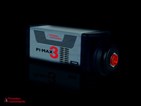Faster, Smarter Generation Of Intensified CCD (ICCD) Cameras Now Available From Princeton Instruments

Princeton Instruments is pleased to introduce the PI-MAX 3, an intensified CCD (ICCD) camera that meets researchers' continually evolving requirements for sensitivity, speed, and control in time-resolved imaging and spectroscopy applications. The new PI-MAX 3 offers readout ranging from video rates (at full 1k x 1k resolution) to thousands of frames per second for capturing dynamics. Its sustained gating repetition rate of 1 MHz is 20 times higher than most research-grade ICCD cameras on the market today, allowing the PI-MAX 3 to keep up with the ever increasing repetition rates of pulsed and modulated lasers.
"The PI-MAX 3 is a fully integrated camera that provides the best combination of frame rate, gating, and low-noise capabilities available," notes Ravi Guntupalli, Product Manager for Princeton Instruments' Imaging Group. "This new ICCD camera sets performance benchmarks for fluorescence lifetime imaging measurements, laser-induced breakdown spectroscopy, pulsed Raman spectroscopy, nanotechnology studies, plasma diagnostics, and many more application areas."
The PI-MAX 3 camera's built-in SuperSynchro timing generator makes setting up complex time-resolved imaging experiments easy. Researchers can use SuperSynchro to store a sequence of gate delays and widths and execute them quickly to generate time vs. intensity data with just a few clicks of a mouse. SuperSynchro also provides the lowest insertion delay on the market, less than 27 nsec.
Another novel PI-MAX 3 feature, SyncMaster technology, helps reduce lab clutter by eliminating the need for an external timing generator. SyncMaster allows the camera to output two continuously running pulse trains to trigger pulsed lasers without interruption, or to trigger Q-switched flashlamp lasers or double-pulse lasers separately. Because the camera's programmable gate widths and delays are generated from the same master clock, the resultant jitter is the lowest possible (typically determined by the laser jitter). The latest Gigabit Ethernet interface allows the PI-MAX 3 to be operated from distances greater than 50 meters away, important for applications such as combustion or plasma studies in which the camera must be kept at a safe distance from host computers.
The PI-MAX 3 can be configured with either a 1024x1024-pixel interline-transfer CCD or a 1024x256-pixel full-frame CCD. A variety of Gen II, Gen III filmless, and Princeton Instruments-exclusive UNIGEN II intensifiers are available for the highest sensitivity from the deep UV to the NIR. All PI-MAX 3 cameras use a windowless design for maximum light throughput.
The new camera also features innovative photocathode cooling for ultra-low-light or single-photon imaging as well as special readout modes for single-shot measurements and particle imaging velocimetry (PIV) applications.
About Princeton Instruments
Princeton Instruments designs and manufactures high-performance CCD, ICCD, and EMCCD cameras; spectrographs; and optics-based solutions for the scientific research, industrial imaging, and OEM communities. We take pride in partnering with our customers to solve their most challenging problems in unique, innovative ways. For more information, visit www.princetoninstruments.com.
SOURCE: Princeton Instruments
